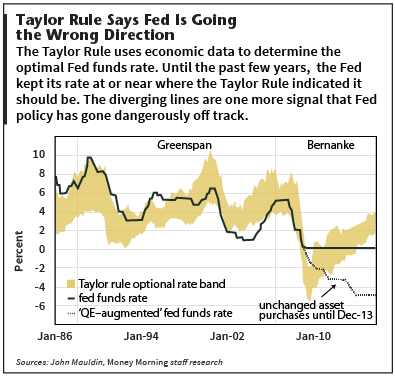Ever heard of the Taylor Rule?
Not many people have, but the folks at the U.S. Federal Reserve are very familiar with it - and they'd probably prefer that this highly respected guideline for the federal funds rate languish in obscurity.
Basically the Taylor Rule is a mathematical equation based on inflation, output, and other economic measures. It was created in 1993 by John B. Taylor, a renowned economics professor at Stanford University.
Ordinarily, the actual Fed funds rate should track within the range of where the Taylor Rule says it should be.
 And for most of the past 30 years, that's pretty much what's happened.
And for most of the past 30 years, that's pretty much what's happened.
But since 2009, the Fed funds rate has diverged from the Taylor Rule - a divergence that's getting bigger all the time.
It's yet another signal that the Fed's easy money policies - namely keeping interest rates near zero while pouring on quantitative easing (bond-buying) that makes effective interest rates negative - are becoming increasingly dangerous the longer they go on.
If the Federal Reserve were following the Taylor Rule, it would not only need to end all QE immediately, but it would actually have to raise interest rates.
And given the outcome of today's (Wednesday's) FOMC meeting, it doesn't look like the Federal Reserve is going to change course anytime soon.
"The Committee decided to await more evidence that [economic] progress will be sustained before adjusting the pace of its purchases," the FOMC statement read.
Translation: "We think the economy still needs our help, so we're going to keep the money-printing presses running at full speed."
That means the lines on the chart above are going to continue to head in opposite directions.
"This divergence is like the 'check engine' light in your car," Money Morning Chief Investment Strategist Keith Fitz-Gerald said. "But instead of looking under the hood, the Fed is ignoring the light and praying to God the engine doesn't blow up."
The Federal Reserve policymakers are disregarding the Taylor Rule, Fitz-Gerald said, because they're convinced they need to keep printing money to stimulate the stubbornly weak U.S. economy.
Yet something doesn't seem to add up...
If the Taylor Rule is based on U.S. economic data, and the Federal Reserve uses U.S. economic data to set policy, why aren't they pointing in the same direction?
"The Fed's statistics are more cooked than a Christmas goose," Fitz-Gerald said, referring to the many adjustments to government statistics like inflation that have rendered them almost meaningless. "They've decided to ignore real-world inputs."
So basically the Federal Reserve is basing its policy on bad data, although they're doing it with their eyes wide open.
But by staying on this dangerous course despite warnings like the Taylor Rule, the Fed is taking a tremendous risk.
Why the Federal Reserve Should Heed the Taylor Rule
One problem Fitz-Gerald sees with Fed policy is that it has pushed the stock market to record levels without the underlying economic activity to support it.
"They're setting up an incredible stock bubble," Fitz-Gerald said. "The markets are up 83% since Q2 of 2009, but consumer spending is up only 9%."
That's become a problem in and of itself, he added.
"People are confusing the stock market gains with real growth," Fitz-Gerald said. "What the Fed is doing is not working. We have margin levels at record highs, the middle class getting squeezed with higher inflation, high unemployment."
In addition to stocks, Fitz-Gerald said Federal Reserve policy has also created a "bond market bombshell" and has launched a fresh wave of "currency wars," in which countries try to devalue their currencies to make their exports cheaper.
Sooner or later, the bubbles will burst. But instead of pulling back, the Federal Reserve just keeps creating more money, setting us all up for an even bigger economic disaster.
The trouble is, we've already gone way beyond the point of easy fixes.
Warning lights like the Taylor Rule keep flashing faster and more brightly, but the people who should be paying attention - the Federal Reserve and their supposed overseers, the U.S. Congress - know any attempt to deal with the problem would also be extremely disruptive.
"They want all gain and no pain, which contradicts the fundamental precept of capitalism - which is that failure and risk/reward go hand-in-hand," Fitz-Gerald said.
So America's decision makers all just close their eyes and cross their fingers.
"We don't know exactly when this engine will blow up," Fitz-Gerald said, "but they're all just hoping it won't happen on their watch."
The financial bubbles the policies of the Federal Reserve are creating present a clear and present danger to your money. But you can do something about it. Keith Fitz-Geraldhas some great advice on what you can do to prepare for the bursting of the bubbles...
Related Articles:
- Money Morning:
Fed Strategy from Mohammed Ali - Money Morning:
The First Thing Yellen Should Do to Save America
About the Author
David Zeiler, Associate Editor for Money Morning at Money Map Press, has been a journalist for more than 35 years, including 18 spent at The Baltimore Sun. He has worked as a writer, editor, and page designer at different times in his career. He's interviewed a number of well-known personalities - ranging from punk rock icon Joey Ramone to Apple Inc. co-founder Steve Wozniak.
Over the course of his journalistic career, Dave has covered many diverse subjects. Since arriving at Money Morning in 2011, he has focused primarily on technology. He's an expert on both Apple and cryptocurrencies. He started writing about Apple for The Sun in the mid-1990s, and had an Apple blog on The Sun's web site from 2007-2009. Dave's been writing about Bitcoin since 2011 - long before most people had even heard of it. He even mined it for a short time.
Dave has a BA in English and Mass Communications from Loyola University Maryland.



